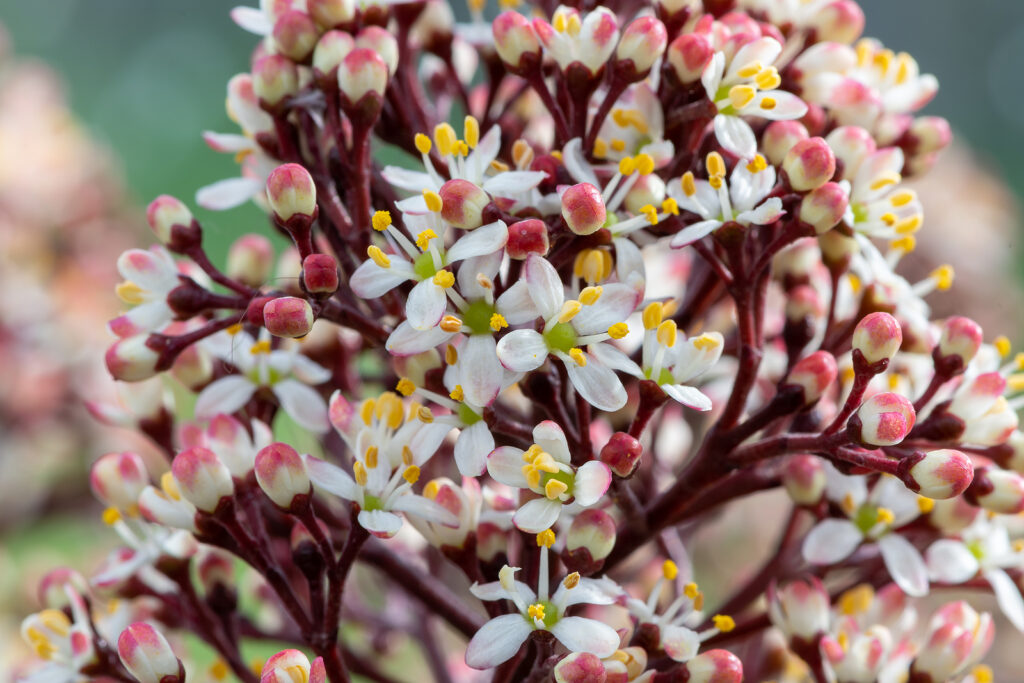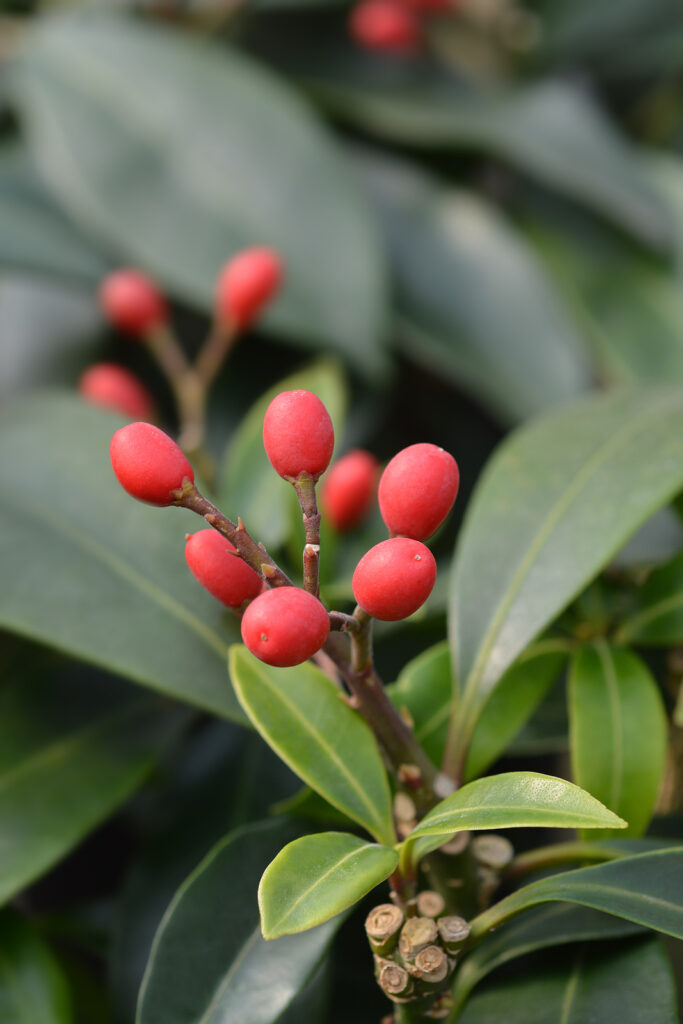Skimmia is a slow-growing evergreen shrub with glossy, dark green leaves. In spring tiny white flowers open from clusters of pinkish buds held above the foliage. Skimmia bears holly-like red fruits in fall and winter. Skimmia is grown for its attractive leaves, flowers, and fruit.
Skimmia flowers are star-shaped and strongly scented in some species. Plant Skimmia under windows, beside shaded walks, flanking entries, and in containers. Skimmia blend well with other shade plants.
Skimmia is a genus of 4 species native to the Himalayas, Southeastern Asia, China, and Japan.

Get to know Skimmia
- Plant type: Broad-leaved evergreen shrubs
- Growing zones and range: Japan, Himalayas
- Hardiness: Zones 6 to 8
- Height and width: 2 to 20 feet (.6-6m) tall and 1.5 to 20 feet (.4-6m0 wide depending on the variety
- Growth rate: Slow
- Form and habit: Rounded
- Foliage: Evergreen, elliptical-oblong, 2.5-5 inches (6.4-12.7cm) long; bright green on top, yellowing underneath, and aromatic when crushed.
- Flowers: Glossy, red-maroon buds open to yellow-white; female flowers are small, somewhat fragrant, .3 inch (.8cm) across, borne on 2-3 inches (5.1-7.6cm) long upright panicles; male flowers are larger, more fragrant.
- Fruits: Female bears hollylike bright red rounded drupes .3 inches (.8cm) wide and conspicuous in fall and winter; male and female plants required for fruit set.
- Bloom time: Spring
- Uses: Mixed evergreen border, understory plants in woodland gardens, along foundations; good under windows, beside shaded walks, flanking entryways, and in containers.
- Garden companions: Rhododendrons, mixed evergreens, with other shade-loving trees.
- Common name: Skimmia
- Botanical name: Skimmia
- Family name: Rutaceae
- Origin: Woodlands Himalayas to China and Japan
Where to plant Skimmia
- Plant Skimmia in light to deep shade; Skimmia will discolor in full sun and does not tolerate heat well.
- Skimmia tolerates urban conditions and containers well.
- Skimmia does not do well in where summer droughts are prolonged.
- Plant Skimmia in well-drained, sandy, moist soil, pH 5.0 to 5.7.

When to plant Skimmia
- A container-grown Skimmia transplants easily in early spring.
Planting and spacing Skimmia
- Space Skimmia 1.5 to 20 feet (.4-6m) apart depending on the variety.
How to water and feed Skimmia
- Skimmia doesn’t tolerate wet conditions or drought.
- Give Skimmia regular water.
- Feed Skimmia with an all-purpose organic fertilizer in spring.
How to care for Skimmia
- The pruning season for Skimmia is after flowering.
- A Skimmia looks best if allowed to develop naturally.
- Ungainly branches should be removed from Skimmia in spring before growth begins.
Skimmia pests and diseases
- Skimmia is susceptible to attack by mites, which give the foliage a sunburned look; thrips may also attack.
- Water mold is a problem for Skimmia in hot regions.

Skimmia propagation
- Propagate Skimmia from cleaned seeds or cuttings taken in fall.
- Sow seed in containers in a cold frame in autumn.
- Root semi-ripe cuttings with bottom heat in mid- and late summer.
Skimmia varieties to grow
- Skimmia japonica, Japanese skimmia, a dainty, slow-growing, densely branched shrub 3-5 feet (.9-1.5m) high with glossy, elliptical leaves that are slightly fragrant when bruised and held in whorls near the ends of branches. The female plant bears yellowish-white flowers; the male, larger, fragrant flowers. The fruits are borne by female plants when a male plant is growing nearby. Zones 7 and 8.
- S. foremanii, hybrid between S. japonica and S. reevesiana. Resembles S. japonica but is more compact, with broader, heavier, darker green leaves. Plants may be male, female, or self-fertile.
- S. reevesiana, Reeves skimmia, a less-hardy species for Zones 7 to 8. A compact shrub, it grows 2-3 feet (.6-.9m) high and bears white flowers that are bisexual. One plant alone will fruit. Where there’s no room for both male and female shrubs, gardeners choose this species. Zones 6 and 7.















